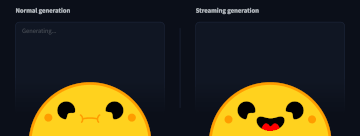6.5 KiB
Streaming
What is Streaming?
Token streaming is the mode in which the server returns the tokens one by one as the model generates them. This enables showing progressive generations to the user rather than waiting for the whole generation. Streaming is an essential aspect of the end-user experience as it reduces latency, one of the most critical aspects of a smooth experience.


With token streaming, the server can start returning the tokens one by one before having to generate the whole response. Users can have a sense of the generation's quality earlier than the end of the generation. This has different positive effects:
- Users can get results orders of magnitude earlier for extremely long queries.
- Seeing something in progress allows users to stop the generation if it's not going in the direction they expect.
- Perceived latency is lower when results are shown in the early stages.
- When used in conversational UIs, the experience feels more natural.
For example, a system can generate 100 tokens per second. If the system generates 1000 tokens, with the non-streaming setup, users need to wait 10 seconds to get results. On the other hand, with the streaming setup, users get initial results immediately, and although end-to-end latency will be the same, they can see half of the generation after five seconds. Below you can see an interactive demo that shows non-streaming vs streaming side-by-side. Click generate below.
How to use Streaming?
Streaming with Python
To stream tokens with InferenceClient, simply pass stream=True and iterate over the response.
from huggingface_hub import InferenceClient
client = InferenceClient("http://127.0.0.1:8080")
for token in client.text_generation("How do you make cheese?", max_new_tokens=12, stream=True):
print(token)
# To
# make
# cheese
#,
# you
# need
# to
# start
# with
# milk
#.
If you want additional details, you can add details=True. In this case, you get a TextGenerationStreamResponse which contains additional information such as the probabilities and the tokens. For the final response in the stream, it also returns the full generated text.
for details in client.text_generation("How do you make cheese?", max_new_tokens=12, details=True, stream=True):
print(details)
#TextGenerationStreamResponse(token=Token(id=193, text='\n', logprob=-0.007358551, special=False), generated_text=None, details=None)
#TextGenerationStreamResponse(token=Token(id=2044, text='To', logprob=-1.1357422, special=False), generated_text=None, details=None)
#TextGenerationStreamResponse(token=Token(id=717, text=' make', logprob=-0.009841919, special=False), generated_text=None, details=None)
#...
#TextGenerationStreamResponse(token=Token(id=25, text='.', logprob=-1.3408203, special=False), generated_text='\nTo make cheese, you need to start with milk.', details=StreamDetails(finish_reason=<FinishReason.Length: 'length'>, generated_tokens=12, seed=None))
The huggingface_hub library also comes with an AsyncInferenceClient in case you need to handle the requests concurrently.
from huggingface_hub import AsyncInferenceClient
client = AsyncInferenceClient("http://127.0.0.1:8080")
async for token in await client.text_generation("How do you make cheese?", stream=True):
print(token)
# To
# make
# cheese
#,
# you
# need
# to
# start
# with
# milk
#.
Streaming with cURL
To use the generate_stream endpoint with curl, you can add the -N flag, which disables curl default buffering and shows data as it arrives from the server
curl -N 127.0.0.1:8080/generate_stream \
-X POST \
-d '{"inputs":"What is Deep Learning?","parameters":{"max_new_tokens":20}}' \
-H 'Content-Type: application/json'
Streaming with JavaScript
First, we need to install the @huggingface/inference library.
npm install @huggingface/inference
If you're using the free Inference API, you can use HfInference. If you're using inference endpoints, you can use HfInferenceEndpoint. Let's
We can create a HfInferenceEndpoint providing our endpoint URL and credential.
import { HfInferenceEndpoint } from '@huggingface/inference'
const hf = new HfInferenceEndpoint('https://YOUR_ENDPOINT.endpoints.huggingface.cloud', 'hf_YOUR_TOKEN')
// prompt
const prompt = 'What can you do in Nuremberg, Germany? Give me 3 Tips'
const stream = hf.textGenerationStream({ inputs: prompt })
for await (const r of stream) {
// yield the generated token
process.stdout.write(r.token.text)
}
How does Streaming work under the hood?
Under the hood, TGI uses Server-Sent Events (SSE). In an SSE Setup, a client sends a request with the data, opening an HTTP connection and subscribing to updates. Afterward, the server sends data to the client. There is no need for further requests; the server will keep sending the data. SSEs are unidirectional, meaning the client does not send other requests to the server. SSE sends data over HTTP, making it easy to use.
SSEs are different than:
- Polling: where the client keeps calling the server to get data. This means that the server might return empty responses and cause overhead.
- Webhooks: where there is a bi-directional connection. The server can send information to the client, but the client can also send data to the server after the first request. Webhooks are more complex to operate as they don’t only use HTTP.
If there are too many requests at the same time, TGI returns an HTTP Error with an overloaded error type (huggingface_hub returns OverloadedError). This allows the client to manage the overloaded server (e.g., it could display a busy error to the user or retry with a new request). To configure the maximum number of concurrent requests, you can specify --max_concurrent_requests, allowing clients to handle backpressure.